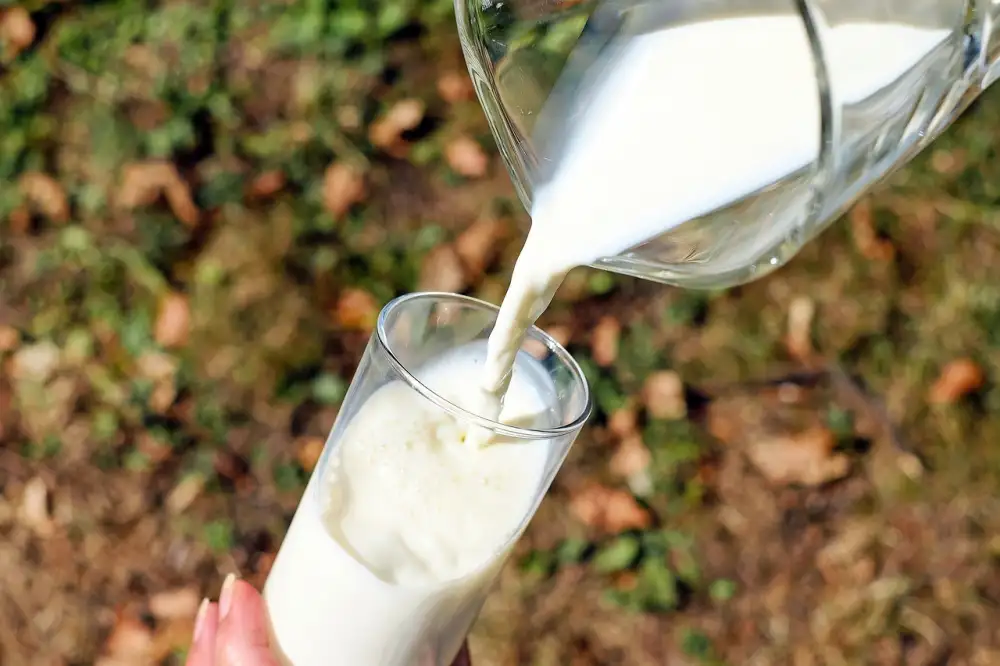Unveiling the Truth: Does Almond Milk Go Bad? A Comprehensive Guide to Almond Milk Shelf Life and Spoilage Signs for Optimal Health

- Exploring the shelf life and spoilage signs of almond milk
- Understanding almond milk
- Brief explanation of almond milk and its popularity
- Shelf life of almond milk
- Factors affecting the shelf life of almond milk
- Typical expiration dates for unopened and opened almond milk
- Signs of spoilage in almond milk
- Visual cues indicating almond milk has gone bad
- Changes in texture and smell as spoilage indicators
- Proper storage of almond milk
- Tips for extending the shelf life of almond milk
- Best practices for storing almond milk to prevent spoilage
- Health risks of consuming spoiled almond milk
- Potential dangers and health concerns associated with drinking spoiled almond milk
- Importance of being aware of almond milk's shelf life and spoilage signs for optimal health and taste
When it comes to alternative milk options, almond milk has become increasingly popular among health-conscious individuals. With its creamy texture and nutty flavor, almond milk has gained a loyal following. However, like any perishable product, almond milk does have a limited shelf life. In this comprehensive guide, we will explore the factors that affect the shelf life of almond milk and discuss the telltale signs of spoilage. By understanding how to properly store and identify spoiled almond milk, you can ensure optimal health and taste in every sip.
Exploring the shelf life and spoilage signs of almond milk
Almond milk, a popular dairy alternative, has gained significant popularity in recent years due to its numerous health benefits and versatility in cooking and baking. However, like any perishable product, almond milk does have a shelf life and can spoil if not stored properly. In this comprehensive guide, we will delve into the shelf life of almond milk and explore the telltale signs of spoilage to ensure you always enjoy fresh and safe almond milk for optimal health.
Understanding almond milk
Almond milk, a popular dairy-free alternative, is made by blending almonds with water and then straining the mixture. It has gained popularity due to its creamy texture and nutty flavor. Almond milk is also a great option for those who are lactose intolerant or follow a vegan diet. It is packed with nutrients like vitamin E, calcium, and healthy fats. However, it's important to understand the basics of almond milk in order to determine its shelf life and spoilage signs accurately.
Brief explanation of almond milk and its popularity
Almond milk, a popular dairy alternative, is made by blending almonds with water and straining the mixture to remove any solids. It has gained popularity due to its creamy texture, nutty flavor, and various health benefits. Almond milk is naturally lactose-free, making it suitable for those with lactose intolerance or dairy allergies. Additionally, it is low in calories and contains no cholesterol or saturated fats. Its versatility makes it a favorite choice for vegans and individuals seeking a plant-based milk option.
Shelf life of almond milk
The shelf life of almond milk can vary depending on various factors. Unopened almond milk typically has a longer shelf life compared to opened almond milk. On average, unopened almond milk can last up to one year past the printed expiration date. However, once opened, almond milk should be consumed within 7-10 days for optimal freshness and taste. It is important to check the expiration date on the packaging and consume it before that date to ensure its quality. Proper storage is also crucial in extending the shelf life of almond milk.
Factors affecting the shelf life of almond milk
Several factors can affect the shelf life of almond milk. One key factor is the processing method used. Almond milk that has been pasteurized and treated with high-pressure processing tends to have a longer shelf life compared to raw almond milk.
Another factor is the packaging. Almond milk that comes in aseptic packaging, such as cartons or bottles, has a longer shelf life because it is protected from light and air. On the other hand, almond milk sold in glass bottles or containers may have a shorter shelf life due to increased exposure to light and air.
Additionally, the storage conditions play a crucial role in determining the shelf life of almond milk. Keeping almond milk refrigerated at temperatures below 40°F (4°C) helps slow down bacterial growth and extends its freshness. It's important to note that once almond milk is opened, its shelf life decreases significantly, typically lasting only 7-10 days when stored properly in the refrigerator.
Understanding these factors can help consumers make informed decisions about purchasing and consuming almond milk for optimal taste and health benefits.
Typical expiration dates for unopened and opened almond milk
The typical expiration date for unopened almond milk is usually printed on the carton. It can vary depending on the brand and processing methods, but it is typically around 7-10 days past the purchase date. Once opened, almond milk should be consumed within 7-10 days for optimal freshness and taste. However, it is important to note that these dates are just guidelines and the quality of almond milk may start to deteriorate before the expiration date if not stored properly.
Signs of spoilage in almond milk
Signs of spoilage in almond milk can be easily identified through visual cues and changes in texture and smell. When almond milk goes bad, it may develop clumps or curdled chunks, indicating bacterial growth. The color may also change from creamy white to a yellowish or grayish tint. Additionally, a sour or off-putting odor is a clear sign that the almond milk has spoiled. It is important to discard any almond milk that shows these signs of spoilage to avoid potential health risks.
Visual cues indicating almond milk has gone bad
Visual cues indicating almond milk has gone bad can be easily spotted. One of the first signs is the separation of the liquid, where you may notice a layer of thick sediment at the bottom. Additionally, if you see any clumps or chunks floating in the milk, it is a clear indication that it has spoiled. Another visual cue is a change in color; if the almond milk appears yellowish or has turned into a darker shade, it is likely no longer safe to consume.
Changes in texture and smell as spoilage indicators
Changes in texture and smell are important indicators of spoilage in almond milk. When almond milk goes bad, it may develop a thicker or clumpy texture. The smooth consistency that is characteristic of fresh almond milk will be compromised. Additionally, the smell of spoiled almond milk will be noticeably sour or rancid. These changes in texture and smell should not be ignored as they can indicate the presence of harmful bacteria or mold growth. It is essential to discard any almond milk that exhibits these spoilage signs to ensure optimal health and taste.
Proper storage of almond milk
Proper storage of almond milk is crucial for maintaining its freshness and extending its shelf life. To ensure optimal quality, it is recommended to store unopened almond milk in a cool and dry place, away from direct sunlight and heat sources. Once opened, it should be refrigerated at all times. It is important to tightly seal the container after each use to prevent air exposure and contamination. Additionally, avoid storing almond milk near strong-smelling foods as it can absorb odors easily. By following these storage practices, you can enjoy your almond milk for longer periods while preserving its taste and nutritional value.
Tips for extending the shelf life of almond milk
To extend the shelf life of almond milk, it is important to follow a few simple tips. Firstly, always check the expiration date before purchasing almond milk. Opt for brands that have a longer shelf life. Once opened, keep the almond milk refrigerated at all times and consume it within 7-10 days. Avoid leaving the carton out of the refrigerator for extended periods of time as this can promote bacterial growth. Additionally, make sure to seal the carton tightly after each use to prevent air and moisture from entering. Lastly, avoid freezing almond milk as it can alter its texture and taste. By following these tips, you can enjoy fresh and safe almond milk for a longer period of time.
Best practices for storing almond milk to prevent spoilage
To prevent spoilage and extend the shelf life of almond milk, it is crucial to store it properly. Firstly, always keep almond milk refrigerated at a temperature below 40°F (4°C). Avoid leaving it out at room temperature for extended periods. Additionally, make sure to tightly seal the carton or bottle after each use to prevent air and bacteria from entering. It is also advisable to store almond milk away from strong-smelling foods as it can absorb odors easily. Lastly, if you have opened a large container of almond milk but won't consume it all within a few days, consider transferring smaller portions into airtight containers before refrigerating them. These best practices will help maintain the freshness and quality of your almond milk for a longer period.
Health risks of consuming spoiled almond milk
Consuming spoiled almond milk can pose health risks and potential dangers to individuals. When almond milk goes bad, it may contain harmful bacteria or molds that can cause foodborne illnesses. These can lead to symptoms such as nausea, vomiting, diarrhea, and stomach cramps. In some cases, consuming spoiled almond milk may even result in more severe complications for individuals with weakened immune systems. It is crucial to be aware of the signs of spoilage and discard any almond milk that has passed its expiration date or shows visible signs of spoilage to ensure optimal health and taste.
Potential dangers and health concerns associated with drinking spoiled almond milk
Consuming spoiled almond milk can pose potential health risks and concerns. When almond milk goes bad, harmful bacteria such as Salmonella or E. coli may grow, leading to foodborne illnesses. These bacteria can cause symptoms like nausea, vomiting, diarrhea, and abdominal pain. Additionally, drinking spoiled almond milk may result in allergic reactions for individuals with nut allergies. To ensure optimal health and safety, it is crucial to recognize the signs of spoilage and discard any almond milk that has gone bad.
In conclusion, it is crucial to be aware of the shelf life and spoilage signs of almond milk for both optimal health and taste. Understanding the factors that affect its shelf life, such as proper storage and expiration dates, can help ensure that you consume almond milk at its freshest. By being vigilant about visual cues, changes in texture, and smell, you can easily identify if almond milk has gone bad. Consuming spoiled almond milk can pose potential health risks, so it is important to discard any product that shows signs of spoilage. By following best practices for storage and being mindful of expiration dates, you can enjoy the benefits of almond milk while maintaining your health and well-being.
Importance of being aware of almond milk's shelf life and spoilage signs for optimal health and taste
Being aware of almond milk's shelf life and spoilage signs is crucial for maintaining optimal health and taste. Consuming spoiled almond milk can lead to potential health risks, such as food poisoning and digestive issues. By understanding the typical expiration dates and visual cues indicating spoilage, individuals can ensure they are consuming fresh and safe almond milk. Proper storage techniques also play a vital role in extending the shelf life of almond milk. By following these guidelines, individuals can enjoy the benefits of almond milk without compromising their health or taste preferences.
Published: 10. 12. 2023
Category: Health



